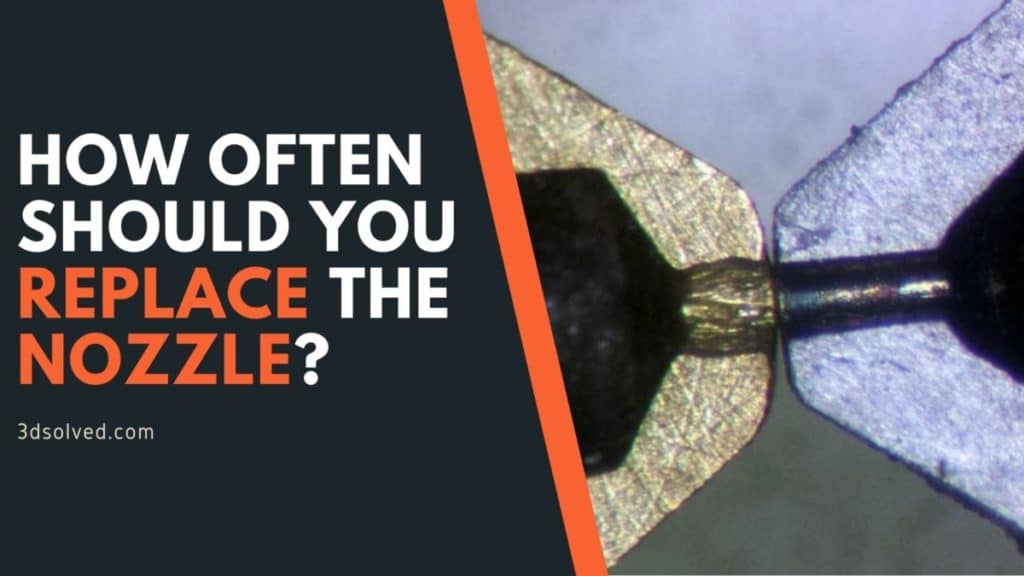There are many additional costs and headaches that come along when you own a 3D printer, and one of the first issues you’ll encounter is that the nozzles will wear out and the print quality will go from a smooth & good looking finish, to something that looks like it was dropped from the 3rd floor.
Joking aside, nozzles have a major impact on the quality of the print and if you want to be able to get quality results, regular maintenance and replacing of the nozzle will be necessary, especially if you’re using a brass one, which is the most common type of nozzle.
This begs the question… “How often should a nozzle be replaced?”. Well, of course the answer is a big “it depends”, because we all use our printers differently: Maybe you print once a week with PLA while someone else prints for 12 hours a day with Polycarbonate, which is a much more abrasive filament that can -and will- deteriorate the nozzle much faster.
This is where nozzles made from other materials, such as hardened steel, come in.
In this article, I will cover the importance of replacing the nozzles on your 3D printer, how to tell whether or not it needs to be replaced, how they can get damaged or worn out, and what other types of nozzles you can use.
In short; The nozzle type you use (brass, steel or ruby-tipped) and the hours your printer is running every day will determine the lifespan of the nozzle; If you print once or twice a week, a brass nozzle will last 3-6 months, but if the printer is running 24/7, it will need replacing every month or so. Stainless- and hardened steel nozzles last for roughly a year and ruby nozzles may last a couple years.
The importance of replacing nozzles
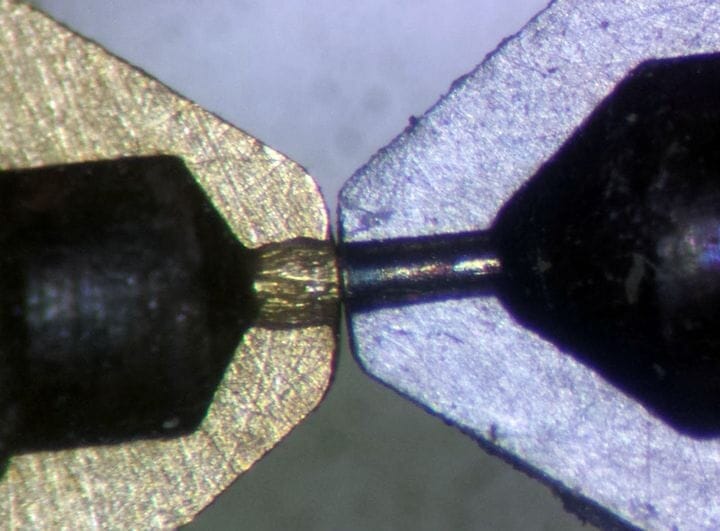
Printing quality can be affected over time by a number of factors (overall nozzle health, leveled print bed, and others) and keeping track of the performance and work hours of your printer’s nozzle is something that will let you determine if it’s time to change the nozzle before encountering issues.
Nozzles will deteriorate over time from simple use, and this is absolutely normal. However, the type of filament you use will have a major impact on the lifespan of a nozzle since non-abrasive materials, such as PLA, are far less harmful to the nozzle than something like Polycarbonate, which is a very abrasive filament type (even though it has its advantages because it’s the strongest filament out there).
If the nozzle starts to deteriorate, you will notice that the print quality follows the same path, since a worn-out nozzle won’t be able to print filament as it’s supposed to (more on how to detect & test your nozzle in a bit).
There are plenty more variables that can affect print quality, not just the nozzle. A good example is the level of your print bed which, if set incorrectly, will get you in a world of trouble.
To maintain a consistent print quality, it is important to make sure that all the different variables that may affect it are in line, and keeping track of your nozzle’s “health” is important.
Potential issues of printing with a worn-out nozzle
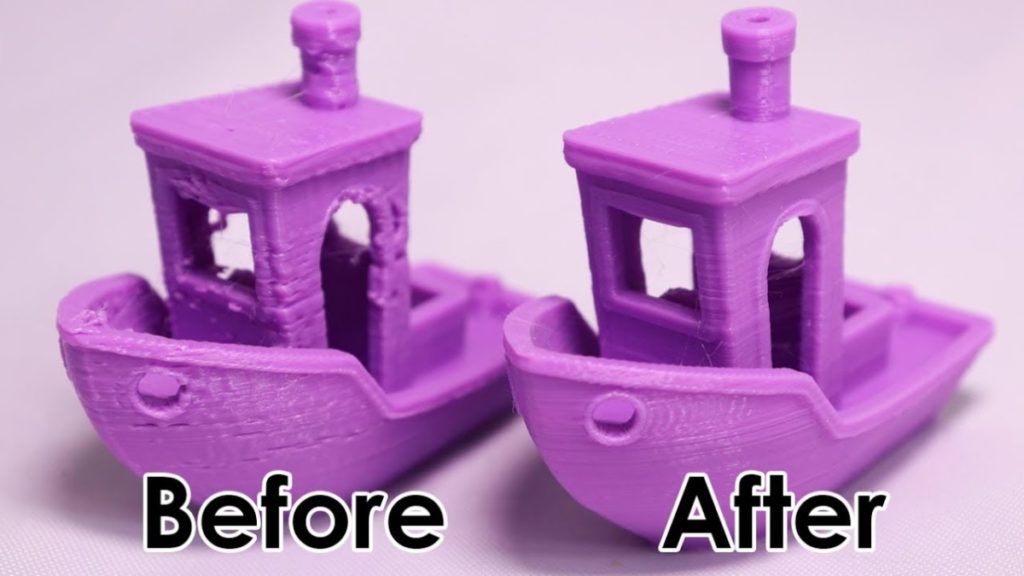
If the fluency and diameter of an extruded plastic are altered in any way, they will diminish the printing quality. The more a nozzle is worn out, the less quality you can expect, not only because of nozzle clogging, but also because the extruded filament may suddenly vary in diameter.
Nozzle clogging is a major concern, and it happens because of wear-and-tear through exposure to high temperatures and the filament type and build-up of carbon, acting as an abrasive inside the nozzle. The groves created on the inside of the nozzle slowly increase the nozzle diameter and present opportunities for clogging to take place.
Additionally, dust and dirt that settle on the filament roll will burn inside of the hot end of the nozzle, and this creates a build-up of carbon that will narrow the extrusion diameter in some areas and inevitably cause clogging and affect print quality.
A worn-out nozzle will affect the Z coordinate due to changes in the nozzle features. As a general rule, the Z height should not be higher than the diameter of the nozzle, nor should it be lower than a quarter of the nozzle diameter.
Print quality depends on the correct Z height, the correct melting temperature at the hot end, a leveled print bed, correct bed temperature if you are using a heated bed, fluent and correct diameter extrusion and other variables like print speed.
All these factors will allow for uninterrupted layer upon layer success. A worn nozzle will result in print complications or total failure.
How to know if the nozzle is worn-out?
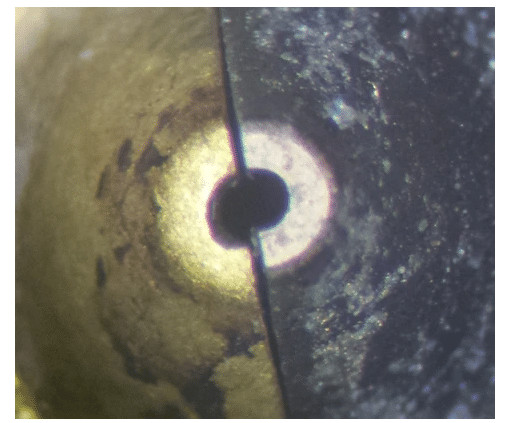
A useful consideration is to have a print quality sample of the same filament on hand that was printed with a new nozzle. Simply compare the result from your worn nozzle to the sample print.
This will give you an indication of quality difference, but the ideal would be to run two tests simultaneously: The first with the worn nozzle and the second with a new replacement nozzle, then visually compare the two.
Another test would be to do an extrusion test: Extrude a short spaghetti length from the worn nozzle and repeat with the new nozzle. The extruded plastic should form a straight line, but if it curls and twists, you know that there is a problem with the old nozzle and replacing it might be the way to go.
You can also use a Vernier to measure the diameter of the two samples: For example, if there is a difference where a 0.4mm nozzle has increased to a 0.5mm diameter, you know that the nozzle is worn out and needs replacing.
It’s also important to check the inside of the nozzle for wear since this is where most nozzle deterioration occurs. Interior deterioration results in uneven extrusion & even clogging, and will affect print quality.
Another test you could do is to look at the shape of the tip of the nozzle: If it has become rounded, you will need to replace it very soon. The nozzle point should be sharp and free of nicks, chips, or accumulated materials.
How nozzles get damaged or worn-out
To bring the price of 3D printers down to a competitive level, they are fitted with cheaper nozzles. The standard nozzle type on new printers is brass which is a fairly soft metal and prone to getting damaged after not too many prints.
However, brass nozzles have the best thermal characteristics for 3D printing. They conduct and retain heat on a consistent basis which is optimal for 3D printing.
Printing with harder and more abrasive materials like nylon, polycarbonate, carbon fiber, composite filaments, and some brands of glow-in-the-dark filament, will cause a lot more stress on the nozzle and wear it out sooner than if you printed with good old PLA.
This will greatly reduce the lifespan of your nozzle and to remedy this you will have to upgrade to nozzles made of harder and stronger materials.
Printing too close to the bed results in several unintended consequences: The nozzle may drag across the surface of the bed, causing damage to both the bed and nozzle which is the last thing you want to happen since replacing the nozzle is easy, but you might need to replace the bed as well.
The lifespan of brass nozzles can be extended by sticking to filaments like PLA, ABS, and PETG, which are smooth and will cause minimum damage to the inside of the nozzle. Essentially, if you want to extend the lifespan of your brass nozzle, avoid abrasive filaments like polycarbonate.
Upgrade to a stainless steel, hardened steel, or ruby-tipped nozzle
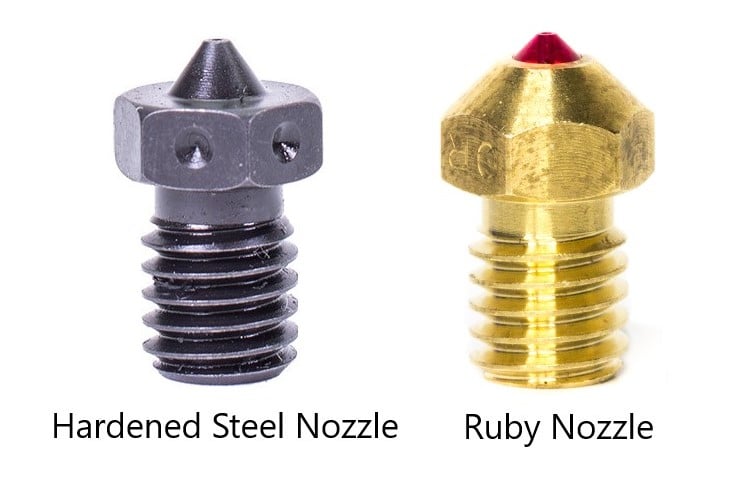
If you intend on printing with abrasive filament types or you want to print food-safe items, then using a stainless-steel nozzle will do the trick. Stainless steel is much harder than brass and will withstand abrasive materials running through it for much longer than a brass nozzle will.
A ruby-tipped nozzle is the Rolls Royce of nozzles and will deliver great results with any filament type while lasting even longer than a stainless- or hardened steel one.
For non-abrasive filament, brass remains the best nozzle type. However, for abrasive materials, stainless-steel is a good alternative if you want to replace nozzles less often, but the ultimate choice is hardened steel.
Hardened steel nozzles have poor thermal conductivity qualities, which means that they are slow to heat and react poorly to retraction and cooling, which may result in higher clogging incidences, but they are much more durable. To avoid this, it will be necessary to adjust your temperature settings.
The main advantage of stainless steel and hardened steel is that filament doesn’t stick to the outside of the nozzle as much, and they are also much easier to clean.
I think it’s safe to say that nozzles should be selected in relation to the filament being used: Printing with PLA or PETG? Use a brass one. Printing with Polycarbonate? Consider using a steel one.
A hardened-steel nozzle will last a year or more, while a brass nozzle will last a few weeks to a few months, depending on the print quantity and filament type. A ruby tipped nozzle will easily last a few years, but it is more expensive than conventional nozzles.
How often should you replace the nozzle?
Nozzles do not have a specific lifespan as there are too many variables associated with their overall durability.
The nozzle with the shortest working hour capacity is the brass nozzle. Even here, we must look at the quality of the brass used to manufacture the nozzle. For this reason, it would be unfair to assign a time/use limit to it, and it’s best to monitor the changes in the nozzle and to determine based on the facts that come from your print quality.
Brass nozzle
Brass nozzles are the most widely used nozzles due to their cost and thermo-conductivity properties. They are perfectly suited to smooth filament types like PLA, ABS, and PETG which suits hobbyists, and although ABS and PETG require higher melting temperatures, it is still within the range of temperatures that brass can comfortably cope with.
Generally, a bronze nozzle used once or twice a week will last 3 to 6 months. With a full daily use (printing for most part of every single day), it might last four weeks or even less.
Stainless-,hardened steel- and Ruby Nozzles
Stainless steel is specifically used for food safe and medical grade printing and it will last longer than brass, but this again depends on the print volume and filament type.
Hardened steel nozzles last much longer than brass and stainless steel ones and they generally last for a year or so with high print volumes and are the nozzles that I’d recommend the most for printing with abrasive materials.
Ruby tipped nozzles normally have a brass body, and the tip will last years while the brass body will conduct and regulate heat, and this essentially means that out of all the nozzle types, ruby tipped nozzles have the longest lifespan.
Ruby tipped nozzles are on the other side of the price spectrum, however, when compared to brass nozzles, but the general consensus is that they are worth the price.
The Olsson high-temperature ruby tipped nozzle can reach printing temperatures as high as 500 degrees C and the body is made from hardened steel and copper, which provide excellent heat conductivity. To eliminate the rough inside of hardened steel, it is coated with chromium nitrate, which prevents the filament from adhering to the surface.
The ruby tip will create flawless extrusion and, when combined with hardened steel, will minimize internal damage. This combination provides the longest lifespan of all printer nozzles, and an upgrade to this standard will be best suited for high-volume printing.
Check out our recommended products section
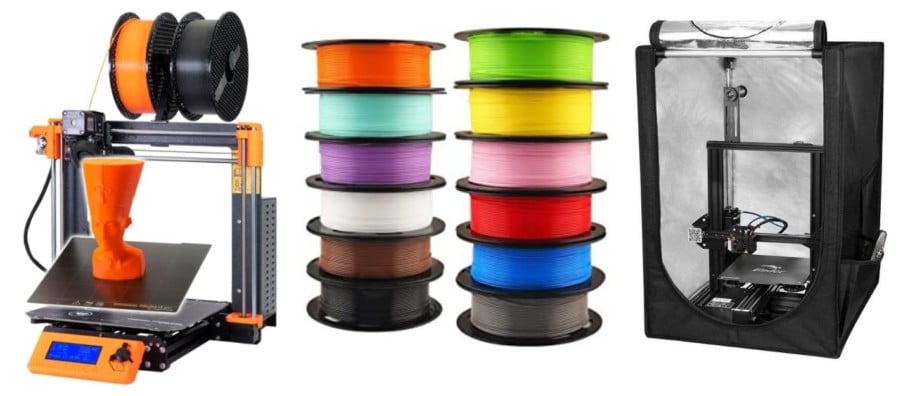
We created a recommended products section that will allow you to remove the guesswork and reduce the time spent researching what printer, filament, or upgrades to get, since we know that this can be a very daunting task and which generally leads to a lot of confusion.
We have selected just a handful of 3D printers that we consider to be good for beginners as well as intermediates, and even experts, making the decision easier, and the filaments, as well as the upgrades listed, were all tested by us and carefully selected, so you know that whichever one you choose will work as intended.
Error processing API data.
